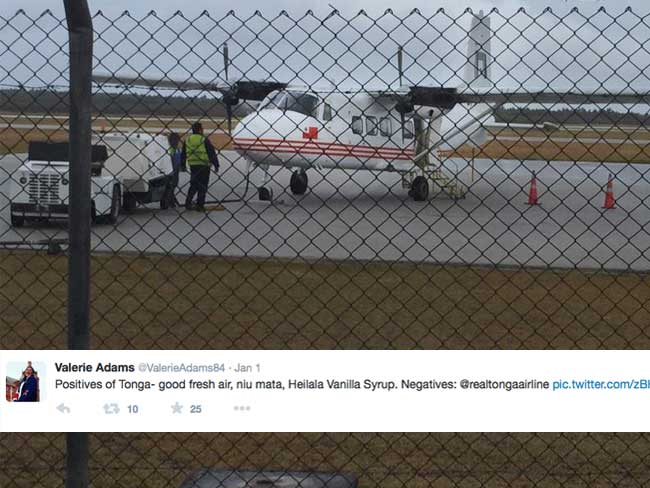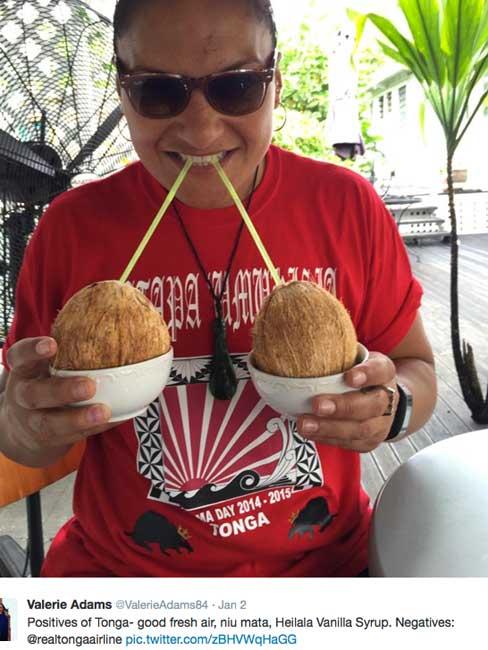By Finau Fonua
A brakes failure on Real Tonga's 12-Harbin Y12 aircraft caused the aircraft to veer on the runway and disrupted flights to 'Eua on Friday January 2.
Heading to 'Eua for the day was the world champion shot-putter and Olympic gold medallist, Valerie Adams who was visiting Tonga with her partner Gabriel Price from December 29 to January 5. Valerie stated on Twitter “Eua plane cancelled due to faulty breaks... Stink @RealTongaAirlin get this sorted”

In a media statement today Tonga's domestic airline apologized to passengers for the flight disruption.
“The scheduled flight operated by a 12-seater Harbin Y12 aircraft was cancelled after one of its brake units malfunctioned, causing the aircraft to veer on the runway as it prepared for take-off,” Real Tonga stated. “The plane was returned to the airport terminal with no further abnormalities.’
The HarbinY12E has since been released for service.
According to Real Tonga, “The engineers with the help of the Chinese Technical Service team from the manufacturer, had rectified the failure on Saturday and the aircraft was released to normal service.
“The airline wishes to apologize to the affected passengers for the disruption and is committed to continually improving its services.”

Gift
The aircraft was a gift from China and presented to Tonga's King Tupou VI in Vava'u last August.
Tonga’s Civil Aviation Authority was criticised for deciding to certify a Y12 aircraft without addressing demands by the International Civil Aviation Organization (ICAO) to upgrade its aircraft certification system. The two specific areas of concern expressed by the ICAO in a letter to the then Director of Tonga’s Civil Aviation, Viliami Cocker on 15 July 2014, was for Tonga to upgrade its aviation safety certification legal frame work, and for Tonga to address its lack of aviation engineering competency.
The Y-12 is the second aircraft to be gifted by China to Tonga, the first was a 56-seater MA60 aircraft that was handed over to the Tongan government on 6 July 2013.
Real Tonga stated today that the aircraft type was certified in other countries. ...“the Harbin Y12E aircraft is type certified by the CAAC of China and the FAA of the United States of America.”





Comments
Na'e kamata 'a hono ngaue'aki
Na'e kamata 'a hono ngaue'aki 'o e fa'ahinga vakapuna ko'eni 'i he ngaahi ta'u 'o e 19valungofulu. Talu mei ai pea mo hono feliuliuaki takai holo mahalo kuo laka hake 'i he tu'o 8. Tanaki atu ngaahi me'a ki he misini, fakalahi pe fakasi'isi'i sea pasese etc. Ko e fo'i liliu pe 'e 2 na'e paasi (certified) 'e he FAA. Ko e pasese 19 'i he 1995, pea mo e pasese 18 'i he 2006. Ko e vaka pasese 12 ko'eni na'e palopalema 'i 'Eua, 'oku te'eki ke ma'u pe na'e 'certified' 'e he FAA pe 'ikai. Na'a kuo taimi ke 'certify' 'a e ki'i vakapuna ni fakatatau ki he fiema'u 'a e kakai. Koe'uhi ka hoko ha me'a, hange ko e fefine mahu'inga ko'eni kuo ne 'ahia mai 'a Tonga, kuo tau fiemalie kotoape he kuo fai hotau lelei taha ke malu'i mo'ui 'a e kakai. ....SAIA
Please Matangi Tonga release
Please Matangi Tonga release the correct and true information to the public in regards the Harbin Y 12 Aircraft made by China manufacturer - that aircraft hasn't been certified by USA FAA and that incident has happened to the aircraft has nothing to do with USA FAA Certification.
In 1991, the USA and China signed a bilateral airworthiness agreement, allowing the FAA and General Administration of Civil Aviation of China to oversee the manufacture of US aircraft in China. Harbin Aircraft Manufacturing (HAMC) and the CAAC applied for Part 23 certification of the Y-12 in September 1992, "leading to modification of the Y-12 II to meet US requirements...", so this proof mentioned above identified that the aircraft operated in Tonga is nothing to do with USA FAA Certification.
USA FAA only certify an Aircraft to operate in USA regardless the aircraft manufacturer and carrier will complied with the USA FAA requirements before they continue to do so - and ever since USA carrier hardly operate that type of aircraft for commercial purpose and the reason you can figure that out and you might know the reason behind right now. The P&W PT6A-27 powered Harbin Y-12-IV is the only FAA certified Chinese civil airliner and unknown to most it has been FAA Part 23 certified since March, 1995 and yet no orders were received, so you see what I mean.
I just want to add this quote from one of the expert in USA Aviation, "This latest US announcement by the Chinese is highly suspicious to me, as was last year’s big Canadian order, as in each case unknown companies are planning on buying large volumes of these Y-12’s, yet no information on buyer, and if this Coptervision is going to operate them around the Grand Canyon then they should already be in business, you don’t walk in and start flying around the Grand Canyon without many approvals, the company should be in business today if its for real.
My years of experience in this industry have given me a good sense for picking up on ‘suspicious’ stories, where something is just not adding up to me, now I have always thought the Y-12 (aka “7/8 scale Twin Otter”) would be ok for North America and wondered why no one has moved on the FAA Part 23 certified aircraft in the past 19 years, but this announcement needs investigation, it could be AVIC’s plan to get attention for the airplane, as they must be frustrated that after 19 years there is not one Y-12 in North America or Europe.
...Tonga’s Civil Aviation Authority was criticised for deciding to certify a Y12 aircraft without addressing demands by the International Civil Aviation Organization (ICAO) to upgrade its aircraft certification system. The two specific areas of concern expressed by the ICAO in a letter to the then Director of Tonga’s Civil Aviation, Viliami Cocker on 15 July 2014, was for Tonga to upgrade its aviation safety certification legal frame work, and for Tonga to address its lack of aviation engineering competency ...in my personal opinion as an Aircraft mechanic from overseas - the Real Tonga mechanic did not carried out their task or duty to the best of their ability in performing service and maintenance... or else they do not know how to service or do maintenance, as the ICAO quoted," Lack of aviation engineering competency." Well it should be a Full Audit to be carried out for the whole of Real Tonga Airlines or else just Shut It Down for the sake of people's safety and lives. If any question in regards my comment mentioned above do not hesitate to contact me.
'Oku ou tui lahi pe e hopo hake ae Palemia foou "Akilisi Pohiva moe puleanga foou o fai ha ngaue kihe issue ko eni he koe moui moe safety ae kakai oku nau heka he vakapuna oku mahuinga taha 'ofa atu ki he Tonga kotoa.
Please be careful what you
Please be careful what you post as your comments can be damaging, especially if they are unfounded.
The Y12E aircraft operating in Tonga is US FAA certified, refer link below:
http://www.airweb.faa.gov/Regulatory_and_Guidance_Library/rgMakeModel.ns...
Reply to visitor01. Please if
Reply to visitor01. Please if you do not understand my comments . . . my comment is stay the same no change. Good luck mate...
Thanks. Your comments are
Thanks. Your comments are understood clearly. The statement in the RT media release that the Y12E is FAA certified was directed towards other media outlets who were quoting that the aircraft involved in this incident was deemed unsafe by NZ and not certified (mistaken obviously for the MA60).
Your rant about China and the US and bilateral agreements was unnecessary and irrelevant.
The fact that you are overseas confirms to me that you are not familiar with the dynamics of the current aviation industry in Tonga.
There have been 2 full audits of RT conducted by independent aviation regulatory authorities that were nominated by the Tongan govt.
As an engineer, you should know that every aircraft is susceptible to the wear and tear of everyday operation. Components will fail.
... Educate yourself with all factors surrounding an incident or story so you can make informed comments next time, instead of running people/organisations down undeservedly just to gain the moral high ground.
Visitor01 thank you for your
Visitor01 thank you for your replied ... unfortunately my previous comment wasn't published in full, and matter of fact you won't get the clear message from me in regards the issue we exchanging comments .... because its only part was published ... but anyway, i don't think that you fully understood my first comments because the way you response tell me the limitation of what you know ... you know what its kind like wasting my time because we are not in the same page, so in order for you to understand how thing works in Aviation Industry .... you were saying that I am not familiar with what has happened in Tonga Aviation, thank you for that but I hope you understand that Tonga is a small islands, and the people work in Tonga Aviation have in their possession a lack of knowledge and experiences. I think that the key factor that causes those incidents in Tonga has been mentioned ... "lack of knowledge and experiences ..." refer as per quote from ICAO to Tonga Civil Aviation... '''to upgrade its aviation safety certification legal frame work..'' and ... ''lack of aviation engineering competency...'''
I am not trying to argue with you, but I try to help because safety and people lives is the first priority. You did mentioned that I should know that every aircraft is susceptible to wear and tear of everyday operation ... Visitor01 are you a Pilot or Mechanic because if you do then you should not fly the plane or fix the plane ... because what you telling me is totally untrue in regards Aviation Industry ...
Let me draw the big pictures in order for you to understand and also upgrade your knowledge in regards Aviation Industry.
As certain items of the airplane and its systems deteriorate, its becomes necessary to assure that the design remains Airworthy ... Maintenance is the action necessary to Sustain or Restore the Airworthy Integrity and Performance of the Airplane. It includes Inspection, Overhaul, Repair, Preservation, and Replacement of Parts. Flying machines can not be of such design that any single failure of the device will have catastrophic results. This is aeronautical dogma. Today's airplanes are subject to very few critical failure modes. this safety-related reliability is attributed to the design requirements of the relevant governmental regulations as well as the specifications of operation organization and manufacturers. Current design practice ensures that vital functions are protected by Redundancy, Fault Tolerance, Fail Tolerance , and Fail Safety Features. This assures that, if there is failure, a given function will remain available from Other Sources to Insure a Safe Completion of Flight.
Visitor01... I'll better pen off right there because people in Aviation Industry will understand my stand point for the issue mentioned .... and this will be my last comments and I don't care if you reply to this statement or not .... I hope you open your eyes and see the Aviation Industry in a big pictures but not just Tonga Aviation only ..... 'Ofa atu ki he Tonga kotoa pe ... Be safe .... submitted by a Tongan .... and proud to be a Tongan ....